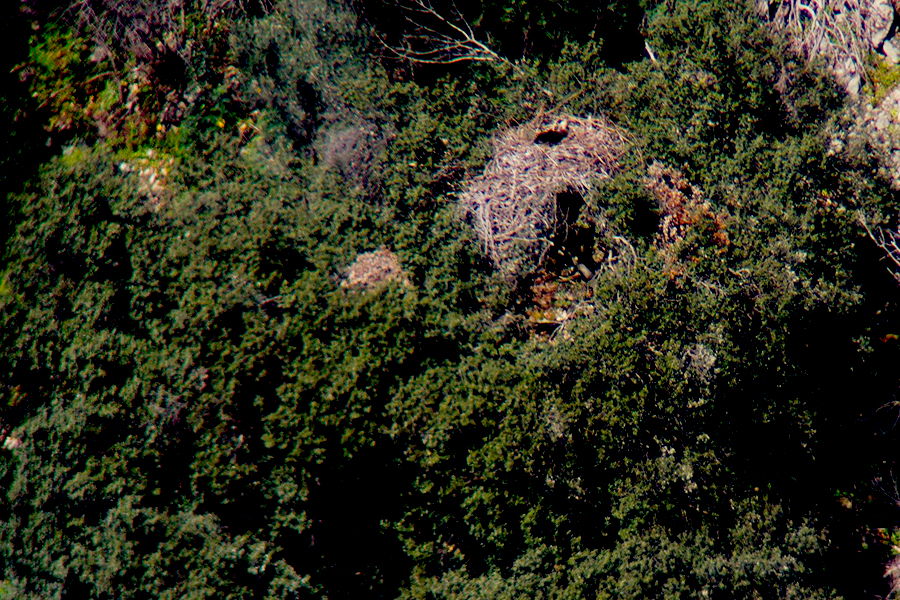
The Vulture Conservation Foundation, alongside its partners, equipped three Cinereous Vulture nestlings with GPS tags in Portugal this summer, and for the first time, in the Douro!
The Cinereous Vulture has the longest breeding period of all raptors in Europe, starting from February, laying one egg between February to April. The breeding pairs incubate eggs for 55-60 days until hatching, and the chick then fledges after 100-115 days. Even when it does, the young vultures still return to the nest for food and to stay the night. Now, all three Cinereous Vultures have fledged the nest, and we have been closely observing their first movements!
Tagging Cinereous Vultures in the Douro
The Douro Canyon is currently home to two Cinereous Vulture breeding pairs, and both of them successfully bred this breeding season! To understand the movements of young individuals in the region, we tagged both 2020 hatched Cinereous Vultures in their nests! The Associação Transumância e Natureza (ATN) and the Instituto da Conservação da Natureza e das Florestas (ICNF) tagged the first vulture on 26 June and the second one on 13 July with GPS tags provided by the VCF with funding from the MAVA Foundation. Tagging Cinereous Vultures in the nest is not an easy task. Conservationists have to climb high to reach the nest of the birds, which is usually on the canopy of trees, and carefully extract the nestling with minimal disturbance, equip it with a tag, which takes skill and experience to do so correctly, and then return it to the nest safely. All went well, and we can now study and monitor the movements of these birds.

The Cinereous Vulture, Cantalpino was the first to fledge the nest on 11 August and just two days later, Lechuga, the second bird, fledged. So far both birds stay in the Douro canyon and the Parque Naturel do Douro Internacional.
Tagging Cinereous Vulture Chaparrito in Herdade da Contenda
In the morning of 3 August, technicians from Liga para a Protecção da Natureza (LPN) alongside Herdade da Contenda equipped yet another Cinereous Vulture nestling that hatched in Contenda, Southern Portugal, with rings and a GPS tag provided by the Vulture Conservation Foundation (VCF) and funded by the MAVA Foundation. According to the feather analysis performed, the vulture is male and was baptized Chaparrito following a public vote. Chaparrito was approximately 85-90 days old when tagged and weighed 6.15 kg. Chaparrito fledged as expected a few weeks after the tagging by the end of August.

He fledged on 28 August and is still flying and staying around the nest area.
Importance of monitoring vultures
GPS tags weigh around 70 g, and yet they provide invaluable information that will help inform more accurate conservation actions. We can understand the bird’s movements, foraging ranges and habits, and realize when a vulture is no longer moving and potentially injured. This information is vital to reveal any threats the bird may face during its travels, giving insights to conservationists that will allow them to carry out actions to reduce the threat it faces and help support the species comeback in the area.
Working for the recovery of Cinereous Vultures

With the recovery of the species in Spain, there has been a range of conservation projects supporting the conservation of the Cinereous Vultures in Portugal such as the cross-borderLIFE Rupis project in the Douro Canyon. Liga para a protecção da natureza (LPN) also led on a multimillion Euro conservation project, Habitat Lince Abutre, which came to an end in 2014 and was supported by the EU’s LIFE+ programme. The project established a network of 10 feeding sites and constructed 30 artificial nesting platforms in and around the Herdade da Contenda, which were instrumental to the successful breeding of pairs in southern Portugal.
Cinereous Vulture in Portugal
The Cinereous Vultures became extinct as breeding species in Portugal in the 1970s, mostly due to the use of poisoned carcasses targeting unwanted predators. An increasing population in Spain saw the species regularly visiting Portugal to forage, with the first pair breeding in central Portugal (Tejo Internacional) in 2010 (where now there is a small colony of more than fifteen pairs), and then in north-eastern Portugal (one single pair). And in 2015 the species recolonised Herdade da Contenda in south-eastern Portugal, and has bred there successfully ever since – there are currently ten breeding pairs there now.










